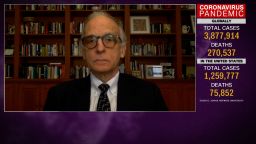Editor’s Note: Kent Sepkowitz is a physician and infectious disease expert at Memorial Sloan Kettering Cancer Center in New York. The views expressed in this commentary are his own. View more opinion on CNN.
Just when you thought that 2022 already had provided a century’s worth of scary infectious diseases, from Covid-19 to monkeypox to polio, last week’s headlines warned of yet another. In eastern China, the Langya virus may have jumped from the white-toothed shrew to humans. It has sickened dozens of people, but has caused no reported deaths.

Many may wonder just what is going on here. Why are so many infections appearing so quickly? Several explanations are plausible: Perhaps a globally warmed and densely populated world is more hospitable to all sorts of new pathogens; perhaps new molecular techniques are allowing us only now to diagnose the cause of the endless unnamed sniffles, colds and rashes that previous generations could not name, creating a concrete “outbreak,” not just a “lousy winter.”
Alternatively, maybe the increasing distrust of science behind the refusals to vaccinate or wear a mask has pushed centuries of medical progress back toward the days of pre-Enlightenment, when only prayer and perhaps a few coins for an indulgence could determine a fate, or perhaps it is the internet feeding a clickbait craving for health scares as if they were scary movies.
Whatever is happening, the moment has created a scramble to find someone who can predict the future, no experience necessary. This search for a crystal ball specialist goes back millennia: The Oracle of Delphi dominates stories from ancient Greece, while astrologers and clairvoyants have filled a similar role for centuries.
Among those with at least a few toes in the scientific world, we have weather forecasters, stock market analysts, political pollsters and Vegas oddsmakers – all of whom are doing their best, but in the final analysis, just guessing, however educated the attempt.
To this list has been added, uncomfortably, a new mythic creature: the public health expert who is able to see the future accurately and declaim what, if anything, we might need to do to stay safe. This is a mighty tall order. We are more than 2 ½ years into the pandemic, and our predictions don’t seem to be improving much.
The twists and turns of the Covid-19 pandemic have humbled us all, possibly compromising the future of predicting the future. Forecasting what might be ahead, even when you know a subject inside out, requires a weird mishmash of expertise, insight, intuition, bravado if not egotism and a taste for the dramatic. But being second- and third-guessed repeatedly threatens to result in timidity and procrastination – the worst traits for anyone trying to prepare for tomorrow. Add in the harsh headwinds provided by an enraged anti-vaccine, anti-science, noisy minority and the task is even more difficult.
For doctors, being wrong, often and early, is part of the daily grind. We are accustomed to it: An X-ray may look abnormal, but, on repeat, the concerning area turns out to be only a tangle of blood vessels. A heart attack that surely seems severe results in a brief and quiet hospital stay, while, in other cases, what seems to be a mild heart attack turns out to be fatal a week later. Every day has its brutal lessons.
Public health is different though. A doctor’s relationship with a patient is a basic human encounter anchored in a shared reality. In contrast, a relationship with a hazily defined public floats about of its own accord without clear rules of engagement. This lack of knowable boundaries is most evident in the ongoing tendency to blame health care experts, not the disease they are trying to control. Or to blame them for what seems a dim recommendation, only to criticize them a day later for delays in their next round of recommendations.
In a certain sense, all this is expected; we all blame the messenger a bit too often. But what is less easy to understand is this: A week after the derision and dismissiveness, the same public hurries to hear the same experts give a pronouncement on the next threat – whatever it is. Experts may flunk test after test, but they never flunk out. To quote from the Woody Allen movie “Annie Hall”: “Boy, the food at this place is really terrible.” “Yeah, I know. And such small portions.”
This last step surely is evident in the report of the Langya virus. Immediately after publication in the New England Journal of Medicine earlier this month, advice to worry or not worry so much about the spread of zoonotic diseases sprang up everywhere. Soon there may be more experts giving advice than cases identified.
Adjusting to news of yet another pathogen surely is unsettling and seeking guidance makes perfect sense. Perhaps though, we should receive the prediction not as an infallible collection of future facts but rather with the same mixture of wariness and hope that we would greet the prediction of a baseball expert who, in August, is tasked with predicting who will win the World Series in October.
Either that or we simply should stop asking people to predict the future. Otherwise, each prediction that misses the mark however slightly serves only to erode public confidence, not just in prognostication but the entire complex enterprise of pandemic control.





